Abstract
The effects on respiration of intravenous infusions of the endogenous nucleoside adenosine and its deaminated metabolite, inosine, administered in random order, single-blind, were compared in six healthy volunteers. The infusion rate of each nucleoside was initially 3.1 mg min-1 and was increased stepwise every 2 min, as tolerated, up to a possible maximum of 23.4 mg ml-1. The maximum dose rates received by all subjects were 8.5 mg min-1 for adenosine and 16.8 mg min-1 for inosine. Adenosine infusion at rates of 6.1 mg min-1 and above caused a significant increase in minute ventilation, principally due to an increase in tidal volume, with an associated significant fall in end-tidal Pco2. Mean inspiratory flow rate increased and expiratory duration decreased during adenosine infusion, but there was no change in inspiratory duration. Adenosine infusion also caused a significant increase in heart rate and a slight, but significant increase in systolic blood pressure. Infusion of inosine at dose rates up to 16.8 mg min-1 produced no pharmacological effects. This study shows that adenosine by infusion produces sustained respiratory stimulation in man and demonstrates that it does not depend on prior conversion of adenosine to inosine or related metabolites and that it is not secondary to systemic hypotension.
Full text
PDF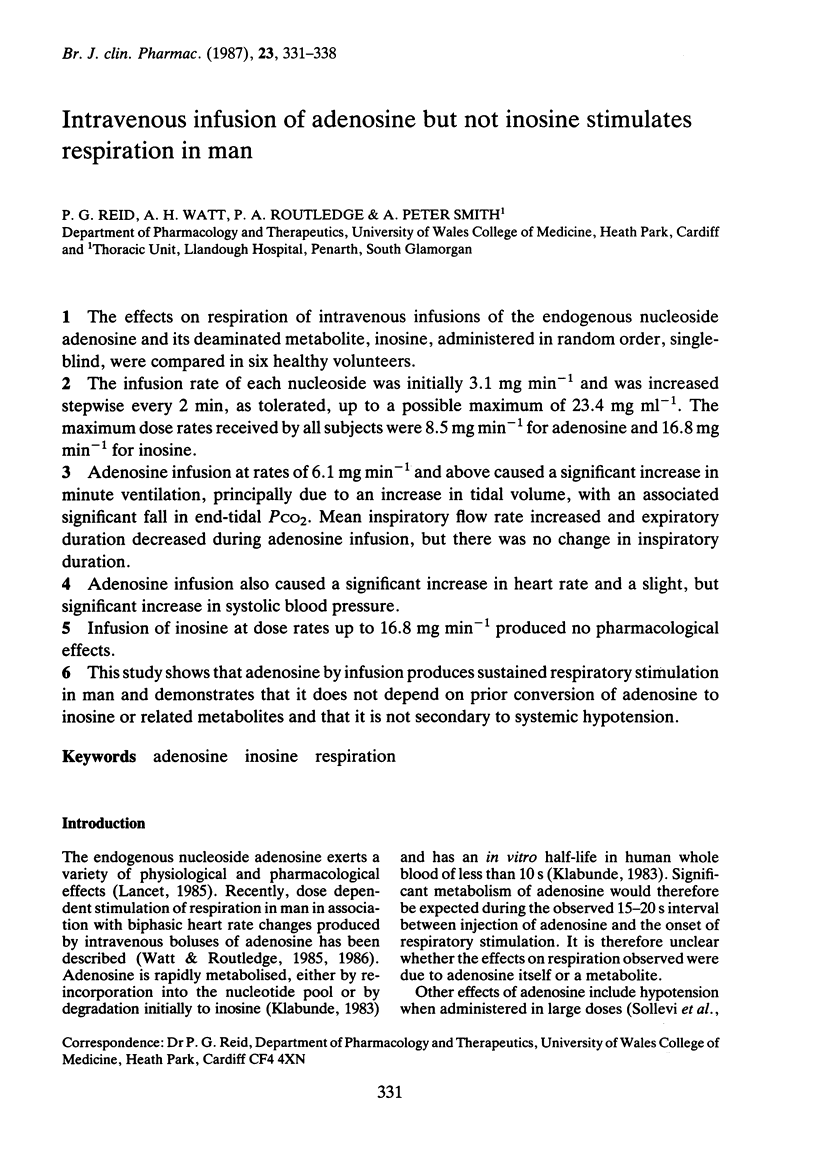
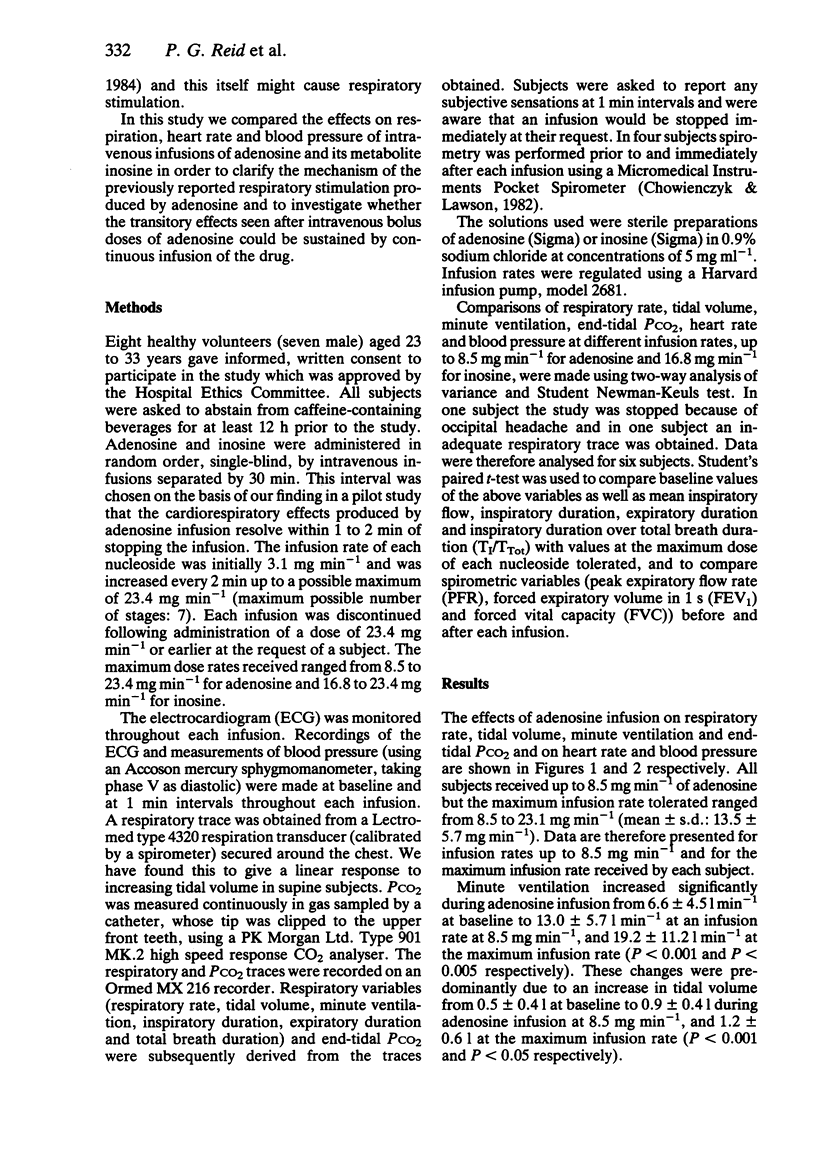
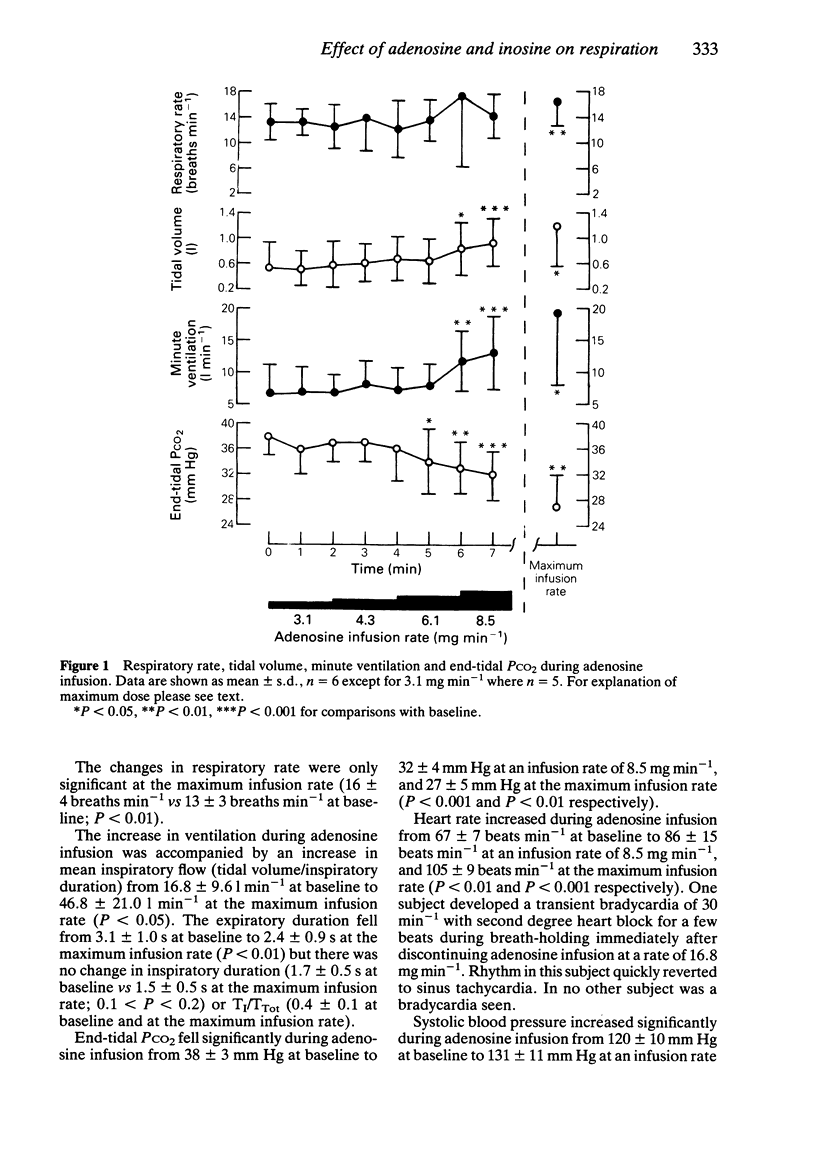
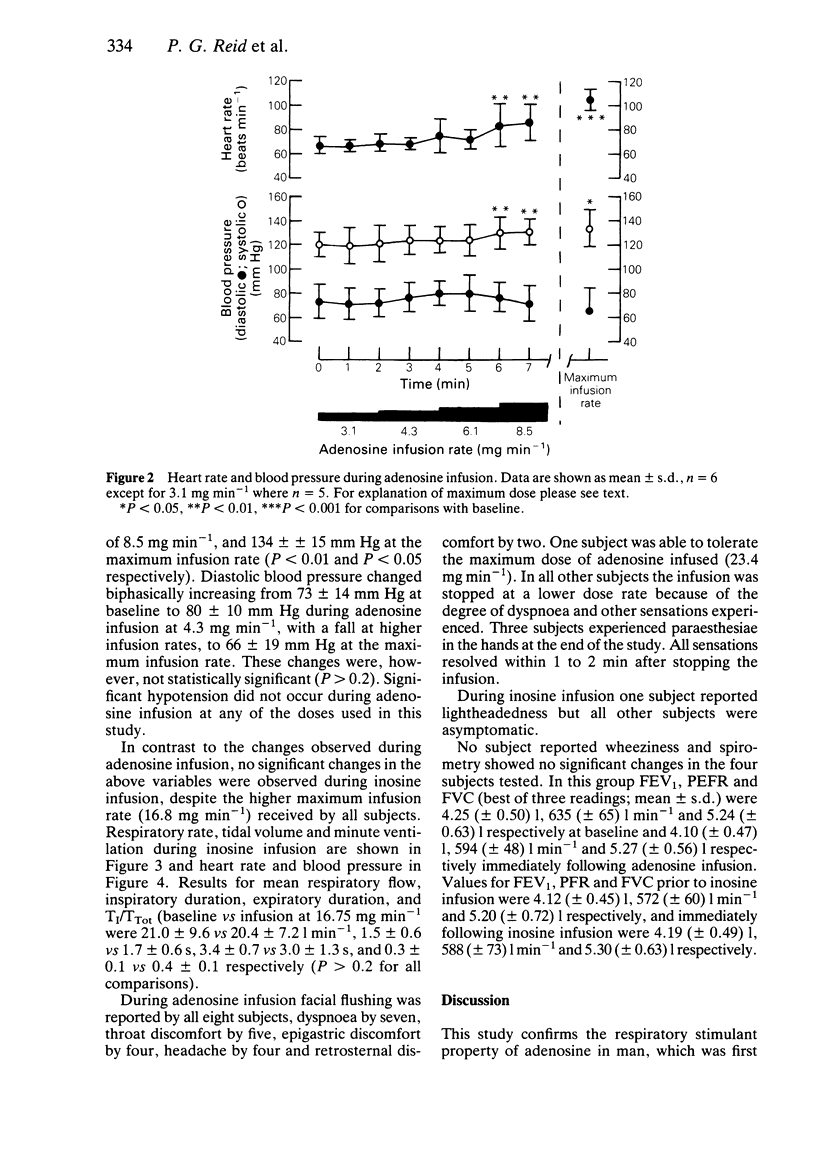
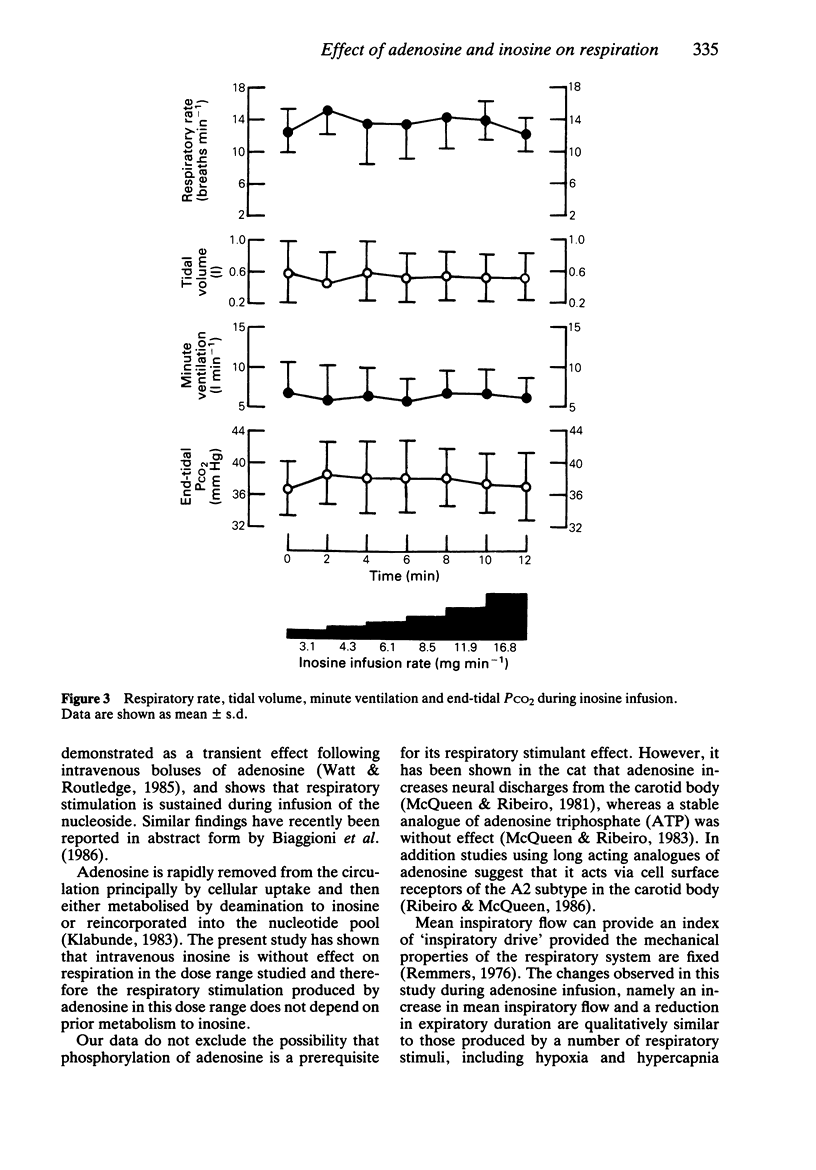

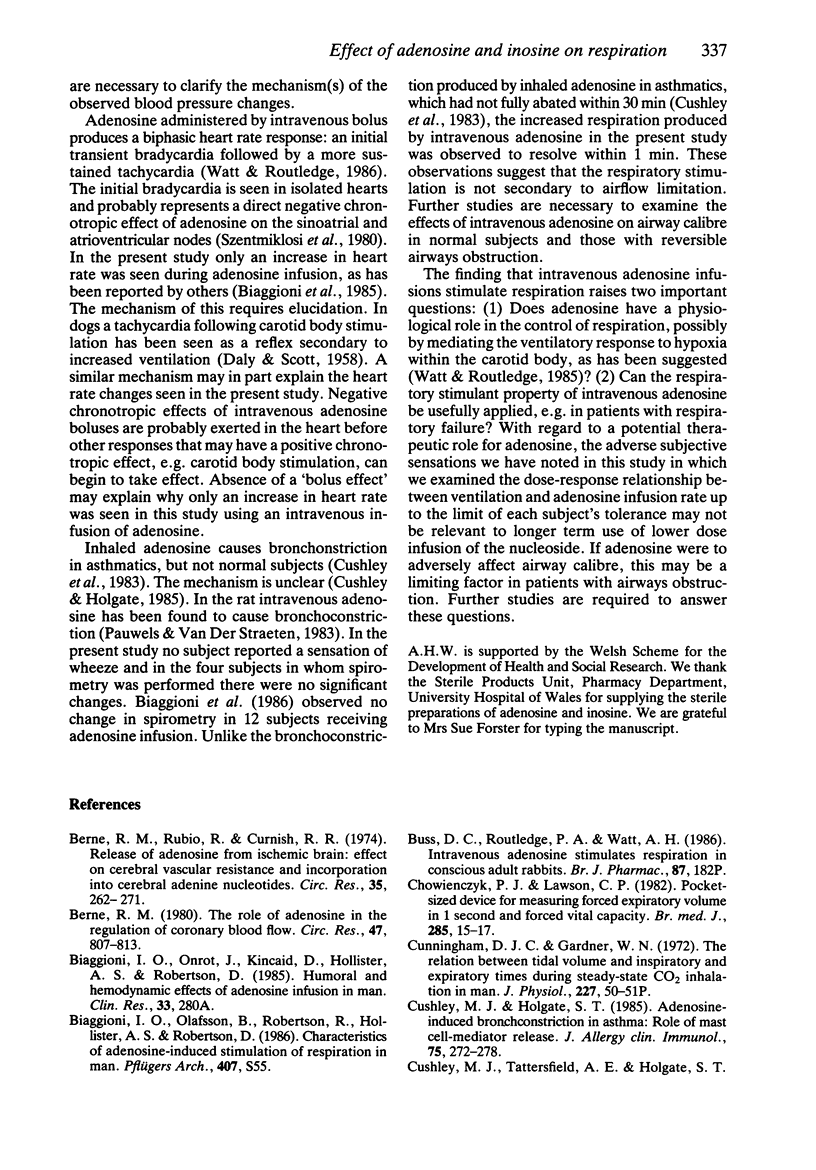
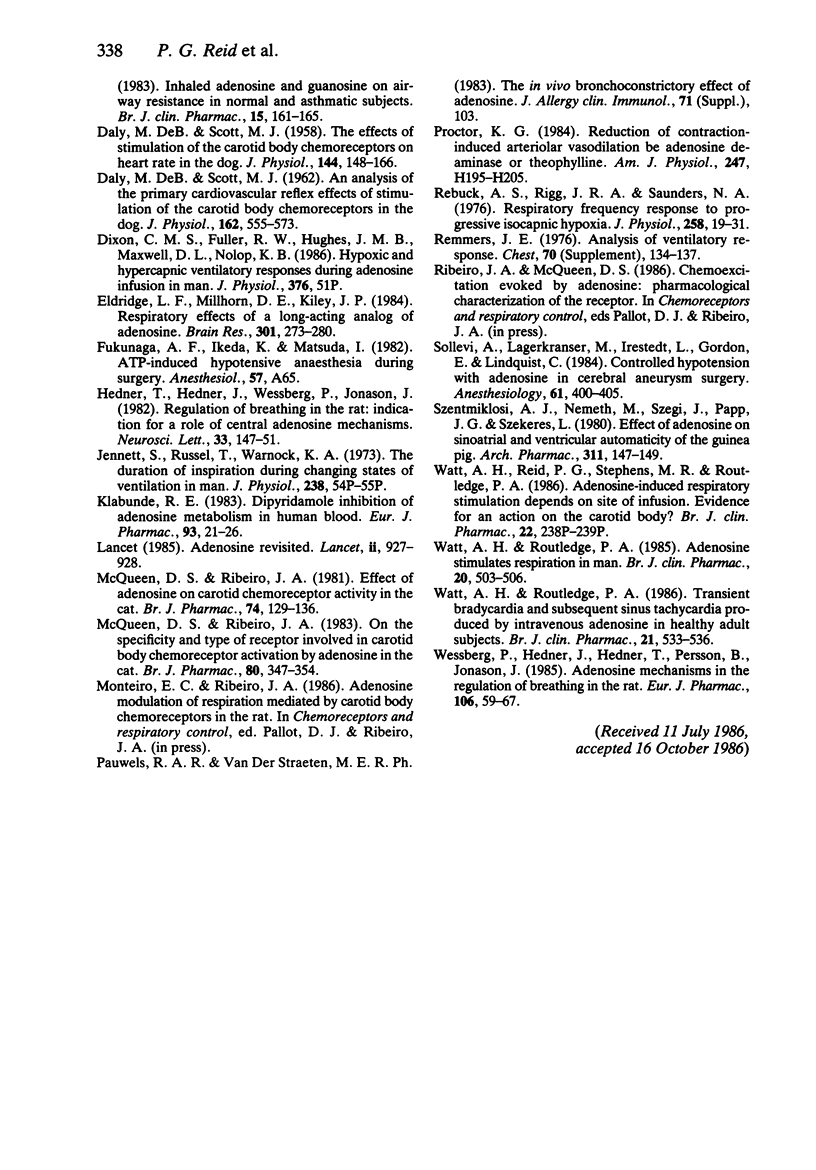
Selected References
These references are in PubMed. This may not be the complete list of references from this article.
- Berne R. M. The role of adenosine in the regulation of coronary blood flow. Circ Res. 1980 Dec;47(6):807–813. doi: 10.1161/01.res.47.6.807. [DOI] [PubMed] [Google Scholar]
- Chowienczyk P. J., Lawson C. P. Pocket-sized device for measuring forced expiratory volume in one second and forced vital capacity. Br Med J (Clin Res Ed) 1982 Jul 3;285(6334):15–17. doi: 10.1136/bmj.285.6334.15. [DOI] [PMC free article] [PubMed] [Google Scholar]
- Cunningham D. J., Gardner W. N. The relation between tidal volume and inspiratory and expiratory times during steady-state CO2 inhalation in man. J Physiol. 1972 Dec;227(2):50P–51P. [PubMed] [Google Scholar]
- Cushley M. J., Holgate S. T. Adenosine-induced bronchoconstriction in asthma: role of mast cell-mediator release. J Allergy Clin Immunol. 1985 Feb;75(2):272–278. doi: 10.1016/0091-6749(85)90057-0. [DOI] [PubMed] [Google Scholar]
- DE BURGH DALY M., SCOTT M. J. An analysis of the primary cardiovascular reflex effects of stimulation of the carotid body chemoreceptors in the dog. J Physiol. 1962 Aug;162:555–573. doi: 10.1113/jphysiol.1962.sp006950. [DOI] [PMC free article] [PubMed] [Google Scholar]
- DE DALY M. B., SCOTT M. J. The effects of stimulation of the carotid body chemoreceptors on heart rate in the dog. J Physiol. 1958 Nov 10;144(1):148–166. doi: 10.1113/jphysiol.1958.sp006092. [DOI] [PMC free article] [PubMed] [Google Scholar]
- Eldridge F. L., Millhorn D. E., Kiley J. P. Respiratory effects of a long-acting analog of adenosine. Brain Res. 1984 Jun 3;301(2):273–280. doi: 10.1016/0006-8993(84)91096-5. [DOI] [PubMed] [Google Scholar]
- Hedner T., Hedner J., Wessberg P., Jonason J. Regulation of breathing in the rat: indications for a role of central adenosine mechanisms. Neurosci Lett. 1982 Nov 30;33(2):147–151. doi: 10.1016/0304-3940(82)90242-7. [DOI] [PubMed] [Google Scholar]
- Jennett S., Russell T., Warnock K. A. Proceedings: The duration of inspiration during changing states of ventilation in man. J Physiol. 1974 Apr;238(1):54P–55P. [PubMed] [Google Scholar]
- Klabunde R. E. Dipyridamole inhibition of adenosine metabolism in human blood. Eur J Pharmacol. 1983 Sep 16;93(1-2):21–26. doi: 10.1016/0014-2999(83)90026-2. [DOI] [PubMed] [Google Scholar]
- McQueen D. S., Ribeiro J. A. Effect of adenosine on carotid chemoreceptor activity in the cat. Br J Pharmacol. 1981 Sep;74(1):129–136. doi: 10.1111/j.1476-5381.1981.tb09964.x. [DOI] [PMC free article] [PubMed] [Google Scholar]
- McQueen D. S., Ribeiro J. A. On the specificity and type of receptor involved in carotid body chemoreceptor activation by adenosine in the cat. Br J Pharmacol. 1983 Oct;80(2):347–354. doi: 10.1111/j.1476-5381.1983.tb10040.x. [DOI] [PMC free article] [PubMed] [Google Scholar]
- Proctor K. G. Reduction of contraction-induced arteriolar vasodilation by adenosine deaminase or theophylline. Am J Physiol. 1984 Aug;247(2 Pt 2):H195–H205. doi: 10.1152/ajpheart.1984.247.2.H195. [DOI] [PubMed] [Google Scholar]
- Rebuck A. S., Rigg J. R., Saunders N. A. Respiratory frequency response to progressive isocapnic hypoxia. J Physiol. 1976 Jun;258(1):19–31. doi: 10.1113/jphysiol.1976.sp011404. [DOI] [PMC free article] [PubMed] [Google Scholar]
- Remmers J. E. Analysis of ventilatory response. Chest. 1976 Jul;70(1 Suppl):134–137. doi: 10.1378/chest.70.1_supplement.134. [DOI] [PubMed] [Google Scholar]
- Sollevi A., Lagerkranser M., Irestedt L., Gordon E., Lindquist C. Controlled hypotension with adenosine in cerebral aneurysm surgery. Anesthesiology. 1984 Oct;61(4):400–405. doi: 10.1097/00000542-198410000-00007. [DOI] [PubMed] [Google Scholar]
- Szentmiklósi A. J., Németh M., Szegi J., Papp J. G., Szekeres L. Effect of adenosine on sinoatrial and ventricular automaticity of the guinea pig. Naunyn Schmiedebergs Arch Pharmacol. 1980 Mar;311(2):147–149. doi: 10.1007/BF00510253. [DOI] [PubMed] [Google Scholar]
- Watt A. H., Routledge P. A. Adenosine stimulates respiration in man. Br J Clin Pharmacol. 1985 Nov;20(5):503–506. doi: 10.1111/j.1365-2125.1985.tb05108.x. [DOI] [PMC free article] [PubMed] [Google Scholar]
- Watt A. H., Routledge P. A. Transient bradycardia and subsequent sinus tachycardia produced by intravenous adenosine in healthy adult subjects. Br J Clin Pharmacol. 1986 May;21(5):533–536. doi: 10.1111/j.1365-2125.1986.tb02838.x. [DOI] [PMC free article] [PubMed] [Google Scholar]
- Wessberg P., Hedner J., Hedner T., Persson B., Jonason J. Adenosine mechanisms in the regulation of breathing in the rat. Eur J Pharmacol. 1984 Oct 30;106(1):59–67. doi: 10.1016/0014-2999(84)90678-2. [DOI] [PubMed] [Google Scholar]


